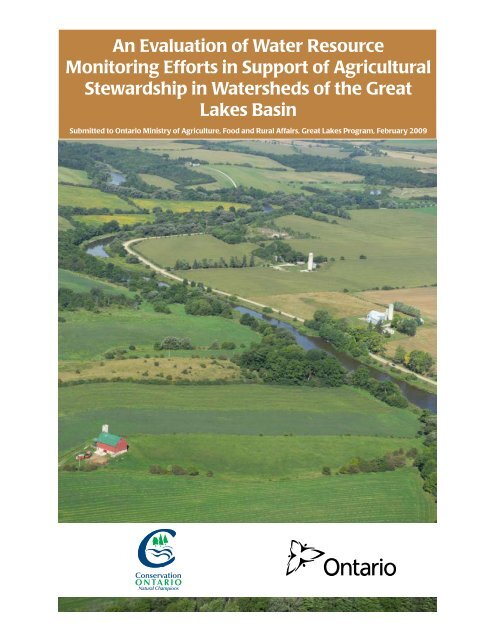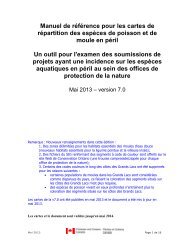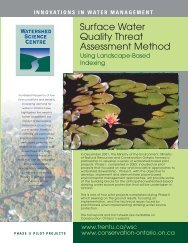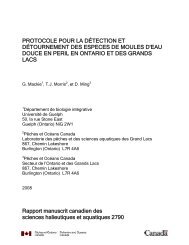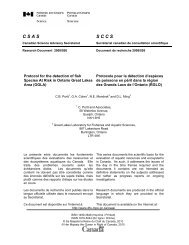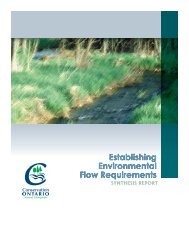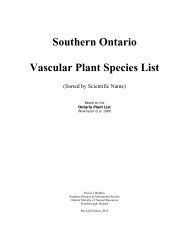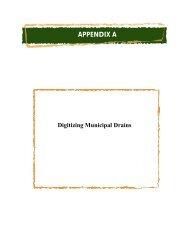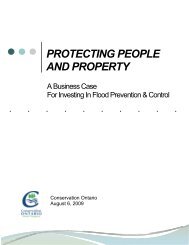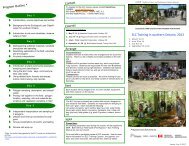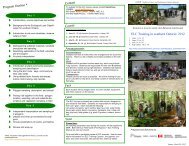kayak - Conservation Ontario
kayak - Conservation Ontario
kayak - Conservation Ontario
You also want an ePaper? Increase the reach of your titles
YUMPU automatically turns print PDFs into web optimized ePapers that Google loves.
This project was made possible through the Great Lakes Program, as part ofthe Canada - <strong>Ontario</strong> Agreement Respecting the Great Lakes Basin Ecosystem.<strong>Conservation</strong> <strong>Ontario</strong>Box 11, 120 Bayview ParkwayNewmarket, <strong>Ontario</strong> L3Y 4W3905-895-0716info@conservationontario.cawww.conservationontario.ca
An Evaluation of Water Resource Monitoring Efforts in Support ofAgricultural Stewardship in Watersheds of the Great Lakes BasinFebruary 2009Executive SummaryOn May 15, 2008 a multi-agency workshop was held to identify successful water resourcemonitoring initiatives, and to analyze how these programs can provide effective, relevantinformation for agricultural stewardship programming in <strong>Ontario</strong>’s Great Lakes basin. Watermonitoring programs provide information that is key to designing, implementing and evaluatingagricultural stewardship programs. This report highlights outcomes from the workshop andrecommendations for water resource monitoring, data sharing, information transfer andcommunication, as well as funding.The workshop attendees were very positive about the value of multi-stakeholder groupscoming together to discuss water resources and stewardship, as well as the need for ongoingopportunities to do this. Participants strongly recommended improved communication andinformation transfer on a practical level to meet the needs of practitioners of both watershedmonitoring and stewardship programming.It was recognized that more coordinated and targeted water resource monitoring is requiredto assess the benefits of ongoing agricultural stewardship programs and to address new andemerging concerns. Building on existing programs and partnerships was seen as an efficientapproach. As such, current mandates and scales of existing monitoring activities can beimproved to supply information for the effective design, implementation and evaluation ofagricultural stewardship programs.i
AcknowledgementsThis project was made possible through the Great Lakes Program, as part of the Canada -<strong>Ontario</strong> Agreement Respecting the Great Lakes Basin Ecosystem.Thanks to Pamela Joosse, OMAFRA, for support and guidance on the project. The followingsteering committee members contributed to workshop planning and project review: PradeepKumar Goel, Ministry of the Environment; Stewart Sweeney, <strong>Ontario</strong> Ministry of Agriculture,Food and Rural Affairs; Rick Steele, Maitland Valley <strong>Conservation</strong> Authority; Sandra Cooke,Grand River <strong>Conservation</strong> Authority; Charley Worte, <strong>Conservation</strong> <strong>Ontario</strong>; Jo-Anne Rzadki,<strong>Conservation</strong> <strong>Ontario</strong>, and Karen Maaskant, Upper Thames River <strong>Conservation</strong> Authority.Kayak Consulting provided design of the group process, workshop facilitation, and summaryreporting. Thanks to Ian Wilcox of Upper Thames River <strong>Conservation</strong> Authority for his input,and also to Chris Wilkinson and Matthew Millar, <strong>Conservation</strong> <strong>Ontario</strong>, for contributing tothe data management section.Acknowledgement goes to the valuable contribution of the 32 participants in the May 15, 2008workshop representing agencies and organizations committed to agricultural stewardship andwater resource monitoring programs (see Appendix C for session participants).This report was prepared for OMAFRA by Karen Maaskant, Upper Thames River <strong>Conservation</strong>Authority, and Jo-Anne Rzadki, <strong>Conservation</strong> <strong>Ontario</strong>.ii
Table of ContentsExecutive Summary .............................................................................................................Acknowledgements .............................................................................................................iiiTable of Contents ................................................................................................................. iii1.0 Introduction ................................................................................................................... 11.1 Background .......................................................................................................... 12.0 Project Approach .......................................................................................................... 23.0 Overview of Findings ................................................................................................... 33.1 Importance of Water Resource Monitoring ........................................................ 33.2 Role of Information Exchange ............................................................................ 33.3 Success Stories .................................................................................................... 44.0 Recommendations ........................................................................................................ 54.1 Water Resources Monitoring ............................................................................... 54.2 Data Sharing ........................................................................................................ 74.3 Information Transfer and Communication ......................................................... 84.4 Funding ................................................................................................................ 95.0 Conclusions .................................................................................................................. 10AppendicesA. List of Examples of Current Water Resource Information Sharing Initiatives ........... 11B. Example of Communications Networks and Initiatives RegardingStewardship and Monitoring ........................................................................................ 12C. An Evaluation of Water Resource Monitoring Efforts in Support ofAgricultural Stewardship in Watersheds of the Great Lakes Basin ............................. 13iii
1.0 IntroductionThe purpose of the project was to identify successful water resource monitoring initiativesthat:• link to and evaluate the benefits of specific agricultural best (beneficial) managementpractices (BMPs), and• evaluate the progress of agricultural stewardship programs in southern <strong>Ontario</strong>watersheds within the Great Lakes basin.The project was initiated as part of OMAFRA’s commitment to the 2007 Canada-<strong>Ontario</strong>Agreement (COA) to restore, protect and conserve the Great Lakes Basin ecosystem. Thisproject supports the following OMAFRA Great Lakes Program commitment:Strategic optimization of multi-agency monitoring and research efforts in support of Annex3 to inform agricultural programs in order to address Great Lakes Basin ecosystem priorities,particularly in the tributaries and near-shore areas. Specifically this project addresses thefollowing outcomes of COA:Annex 4: Coordination of Monitoring, Research and InformationGoal 1: Undertake coordinated and efficient federal/provincial scientific monitoring andresearchResult 1: Responsive and comprehensive monitoring and research programsc) coordinate federal and provincial monitoring and research in support of Annex 3 tooptimize programs and address priorities in the near-shore zones, coastal areas, openwater, and tributaries1.1 BackgroundFaced with growing environmental problems in the 1960s, Canada and the United Statessigned a Great Lakes Water Quality Agreement in 1972 that committed both countries toaddress water quality issues in the Great Lakes basin. Through the 1970s and 1980s, significantadvances were made in identifying the impacts of agriculture on water quality and developingbest (beneficial) management practices (BMPs) that address environmental protection withinproductive agricultural operations.Programs such as Pollution from Land Use Activities Reference Group (PLUARG) in the1970s and Clean Up Rural Beaches (CURB) in the mid-1980s to 1990s are two examples ofearly multi-agency programs whereby research was conducted on the farm-scale and in smallagricultural watersheds to understand the issues. These programs involved extensive watermonitoring and applied research to develop practical solutions with landowners.Many of the environmental issues identified in the past continue to be relevant with currentefforts to address them through agricultural policy and stewardship. Many past BMPs are partof today’s range of solutions and projects for agricultural stewardship programs.Today, new monitoring and applied research is needed to inform agricultural stewardship inlight of other water resource issues of public concern (e.g., climate change, pharmaceuticals).Current threats to Great Lakes water quality, such as major algal blooms linked to phosphoruslevels in Lake Erie, point to the ongoing need for expanded non-point source pollution programsin contributing watersheds.1
2.0 Project ApproachA workshop was held in Puslinch, <strong>Ontario</strong> on May 15, 2008 to bring together expertise fromacross agencies and organizations involved in water resource monitoring and agriculturalstewardship programs in <strong>Ontario</strong>’s Great Lakes basin.Direction and review were provided by a steering committee with representation fromOMAFRA, <strong>Ontario</strong> Ministry of the Environment (OMOE), <strong>Conservation</strong> <strong>Ontario</strong>, andconservation authorities.The workshop participants explored the following topics:• Examples of successful water monitoring projects that inform agricultural stewardship,• Characteristics of successful water monitoring programs or projects,• Water resource information that is most useful in developing an understanding ofthe impacts and effectiveness of agricultural beneficial management practices andprogramming.• Key information/data that is currently available,• Key information/data that is currently unavailable, and• Recommendations for future monitoring programs.This report summarizes the primary discussions and priority recommendations developedthrough the workshop process. The appendices include the workshop facilitator’s completereport, examples of current water resource information initiatives, and examples ofcommunications networks and initiatives regarding stewardship and monitoring2
3.0 Overview of FindingsTwo elements became thefocus of the workshopparticipants’ input: waterresource monitoring andinformation exchange.These elements wereidentified as necessaryto the goal of providingeffective, relevantinformation for agriculturalstewardship programs.3.1 Importance ofWater ResourceMonitoringWa t e r m o n i t o r i n gprovides the means tounderstand the state of thewater resources and themagnitude of effort neededto protect local watershedsand the Great Lakes basin. Workshop participants identified three levels of monitoring to feedinto agricultural stewardship programs.a) Long-term, ambient monitoring through provincial monitoring programs tracks trendsin water quality across <strong>Ontario</strong> and provides valuable information linking land use andcurrent pollution issues (e.g., the regional trends in nitrate concentration in southwestern<strong>Ontario</strong> streams).b) Small agricultural watershed research and monitoring is key to understanding sources,loadings, and fate of pollution in rural tributaries and demonstrating the cumulativebenefits of agricultural stewardship projects at a manageable scale.c) Site specific research and monitoring, as part of the development of new agriculturalBMPs, provides evidence of the environmental benefits of specific stewardship practices.This evidence is important to landowners and governments investing in new stewardshipprojects and initiatives. Workshop participants emphasized that new BMPs must haveproven environmental impacts, as other variables, such as land use activities and climate,can mask the water resource benefits of these projects on a watershed scale. To linkagricultural stewardship programming to water resource benefits, monitoring designneeds to ensure relevant scale and frequency, addressing seasonal weather events andtiming of agricultural practices.3.2 Role of Information ExchangeWorkshop participants emphasized the importance of converting monitoring data intomeaningful information. Monitoring data at all levels (provincial watershed monitoring, smallwatershed research, and farm-scale BMPs) needs to be translated into information that ispractical and relevant to landowners, as well as to government and organizations designing anddelivering agricultural stewardship programs and policy. The effective integration and deliveryof this information to stakeholders is a critical step that workshop participants reported is oftenlacking. A number of efforts are currently underway to improve the availability and exchangeof water resource data and information, as summarized in Appendix A.3
Water resource information needs to be communicated to landowners, extension staff,researchers, and government to ensure practical and effective stewardship programs.Communication facilitates building on existing research and monitoring efforts, whichworkshop participants reported as key to successful research and monitoring projects. Exampleswere cited of projects, such as the Kintore Creek watershed study, where a number of researcherswork in the same watershed and build on and share research data.In promoting BMP adoption, communicating the results of monitoring data can motivatelandowners and local groups to action and help to show environmental benefit for dollarsinvested. One effective approach is the conservation authorities’ watershed report cards, whichpresent data to the public on a smaller-watershed scale and report on environmental changeevery five years. By the end of 2009, 26 <strong>Conservation</strong> Authorities will have completed aWatershed Report Card.3.3 Success Stories – Common Elements of Water ResourceMonitoring Projects that Provide Effective, RelevantInformation for Agricultural StewardshipWorkshop participants provided 42 examples of historical and current water monitoringprojects that have provided effective, relevant information for agricultural stewardship programs(Appendix C). These projects had many common elements as summarized below.Approach or Methodology• Clear purpose• Consistent research and monitoring methods• Correct scientific design including appropriate scale• Integrate a range of technical expertise from relevant disciplines• Continuity – build on previous information, capturing long term information• Results communicated effectively, leading to actionPartnerships• All relevant partners involved – e.g. landowners, government, academia, local agenciesand extension staff• Clear and distinct roles for each partnerFunding• All aspects of the program/project adequately funded, including monitoring, researchand analyses, reporting of information, extension/education, landowner incentivesInformation Benefits• Useful for agricultural technology transfer• Data and results help to develop, refine and support best (beneficial) managementpractices, stewardship policies and programs, and watershed plans• Information linked to current issues/management practices of priority• Create landowner awareness and further motivation for implementation of BMPs• Identify environmental priorities to target programs/resources• Knowledge that is transferable and relevant to public and decision makers4
4.0 RecommendationsThe following recommendations were developed by assessing and synthesizing the informationshared through the workshop. These are the priority recommendations for building upon thesuccesses of past and present water monitoring initiatives that have provided effective, relevantinformation for agricultural watershed stewardship programs.4.1 Water Resource MonitoringRecommendation #1Establish coordinated approaches to water resource data collection and analysis in agriculturalwatersheds, by:• Continuing efforts of the Province and <strong>Conservation</strong> Authorities to establish consistentand scientifically valid protocols for collection, analyses, and reporting of water resourcedata. These protocols will facilitate data sharing, reduce overlap, ensure better researchdesign and outcomes among agencies, and be used in decision making by landownersand other land managers.• Continuing annual provincial-CA technical workshops to train monitoring staff.• Ensuring that provincial water monitoring programs strategically cover agriculturalwatersheds in order to generate results relevant to stewardship programs. This task willrequire an expansion of current OMOE-CA monitoring in some areas of the province.DiscussionOMNR’s Water Resources Information Project (WRIP) clearly identified the need forconsistency in monitoring and reporting. Much progress has been made in ensuring scientificallyvalid protocols in current provincial-CA monitoring programs. There is a need to ensure futuremonitoring is linked to current agricultural stewardship issues along with other current issues.This step will require more effective linking of monitoring to evaluation of the effectiveness ofspecific agricultural BMPs. These efforts need to be established for all three scales of monitoringand address how these levels can interconnect so that monitoring data will be most useful andexchangeable. Technical workshops should involve monitoring personnel and researchers toshare best practices and new research developments. Furthermore, these workshops shouldinclude identification of opportunities for integration of monitoring initiatives with agriculturalstewardship efforts, watershed planning, and other inter-related disciplines.5
Recommendation #2Expand monitoring programs to better measure, understand and address current water resourceissues and the effectiveness of current agricultural BMPs, by:• Aligning monitoring program timing and frequency of sampling with storm andseasonal events and agricultural operations, to more accurately reflect agricultural issuesand mitigation.• Including an assessment of contaminants such as pesticides, pathogens, andpharmaceuticals in new water monitoring initiatives, and providing relevant informationto the agricultural community.• Expanding monitoring programs that assess rural groundwater to better understand thequality and quantity of rural water supplies.DiscussionProvincial water monitoring programs are currently the key set of data used to assess waterresources on a broad scale in watersheds across <strong>Ontario</strong>. For example, the PWQMN isrecognized for its 40 plus years of surface water data at 400 sites across the province. This datais crucial to providing scientific evidence of the need for environmental programs, includingstewardship programming in the Great Lakes basin. In addition, many agencies and institutionsconduct water monitoring as part of research initiatives or local monitoring programs for variousdecision-making and program needs. Integration of this data would benefit many environmentalprograms and initiatives, including stewardship.An increase in monitoring frequency, sites and additional parameters across agriculturalwatersheds would help to assess environmental response to the implementation of specificagricultural BMPs, as well as stewardship programs in general. An integrated watershedmonitoring approach including surface water, groundwater, and aquatic life should be includedin measuring the quality of water resources.6
4.2 Data SharingRecommendation #1Investigate business needs and develop a plan for a more coordinated approach to data collection,with a view to facilitating more efficient data sharing, by:• Investigating data products that support CAs and other stewardship mandates andobjectives.• Completing metadata for all existing owned holdings.• Supporting data sharing frameworks such as the <strong>Ontario</strong> Geospatial Data Exchange(OGDE).• Ensuring that intellectual property rights are in place and understood when sharing thirdparty data, so that data sensitivity is understood and recognized.DiscussionMultiple water resource data related projects are identified in Appendix A. An efficient processis required to define custodians for the various pieces of owned data. A sustained fundingmechanism is needed to ensure owned data is maintained, preferably, and where possible,to a common set of information. This should not be thought of as one large data model to beadopted by every organization and addressing every organization’s needs. For example, thiscould be a series of data models by discipline (stewardship, water quality, etc.). By creatingthe data models where feasible, based on an agreed set of common information, the distributednetwork of data models could “talk to each other.” This would facilitate environmental decisionmakingand benefit integrated watershed-based management. A good first step in discoveringthe data for inclusion into decision making is the population of metadata for each owned dataset. The metadata could be published to a location where the data can be discovered such asOLID (<strong>Ontario</strong> Land Information Directory).Recommendation #2Develop an inventory of publicly accessible information on monitoring projects and programsin <strong>Ontario</strong>. Contributors would include municipal, provincial and federal governments,conservation authorities, and academic and research institutions.Discussion:An inventory could include (but not be limited to): abstract, site locations, data types, timelines,partners, and contacts. Any inventory would ideally be housed by provincial ministries andlink to work updated by CAs and other stakeholders. OLID is one example of a mechanism foridentifying who owns and manages existing monitoring and stewardship information in <strong>Ontario</strong>.Other organizations may wish to implement their own technological solutions, but should stillhold information common to other organizations in order to facilitate sharing, analysis andcommunication between all creators and users of monitoring data and information. CO maybe able to host an inventory of CA monitoring programs, the data for which is owned andmanaged by the CA only. The required input needs to be concise, simple and quick to submitto ensure participation. Good metadata and inventory of monitoring locations is required tomake this exercise straight forward.7
4.3 Information Transfer and CommunicationRecommendation #1Develop communication products based on the results of water monitoring that clearly identifyissues of relevance to agriculture and feed into stewardship programs, by:• Presenting data and information to agricultural producers, landowners, organizations,and agencies through public-friendly documents that support the environmental needand benefits of stewardship actions. For <strong>Conservation</strong> Authorities, it is recommendedthat this include producing watershed report cards, using appropriate and available data,by 2012.• Developing products that summarize key technical outcomes of past (e.g., PLUARG)and current projects to reduce redundancy and build on what has been learned in pastresearch efforts to guide today’s stewardship program development and delivery.• Holding collaborative workshops, starting in 2009, that involve water resourcemonitoring program and agricultural stewardship program personnel to ensure a strongerlink between disciplines. Discussions during these workshops should include improvingapproaches to translating data to information that can be used in effective decisionmaking by technical experts, agricultural producers and landowners.• Developing a steering committee of representatives with expertise from monitoring andstewardship program development and field or local delivery of watershed programs toguide these actions.DiscussionMany past stewardship research programs have clearly demonstrated through long-termresearch and monitoring the sources and pathways of contamination and the measurablebenefits of many BMPs used today. There is a wealth of information that would be relevantto today’s practitioners. A public-friendly product summarizing the findings of this extensiveresearch would be very useful, enhancing and informing policy development and stewardshipprogram development, and would reduce duplication of completed work. An example of afirst step in this process is the current effort to compile and provide web access to PLUARGand other program documents (see http://gis.lrs.uoguelph.ca/AgriEnvArchives/). AppendixB provides some examples of current networks, such as the Stewardship Network of <strong>Ontario</strong>and <strong>Conservation</strong> Authorities Watershed Stewardship Group, that involve sharing informationabout stewardship initiatives towards more effective collaboration and coordination of effortsin implementation. These networks could be one vehicle for transfer of information betweenpractitioners.8
4.4 FundingRecommendation #1Commitment from all levels of government is required to fund water resource monitoringin agricultural watersheds, in order to understand the state of water resources related toagriculture and, thus, develop and refine agricultural stewardship programs. Specifically it isrecommended that:• The Province commit to adequate long-term funding of provincial monitoring programs,including PWQMN, PGMN, OBBN.• The Province expand provincial programs to ensure strategic coverage of agriculturalwatersheds in time and space to address current issues (e.g. pathogens in surface water)at relevant frequency and scale.• Funding be directed to water resource monitoring, research and reporting that issupported by the science, in terms of being effective in assessing emerging issues relatedto agricultural practices and that supports private land management decisions that leadto the development and implementation of best management practices to address thoseissues.DiscussionProvincial water monitoring programs are currently the key set of data used to assess waterresources on a broad scale and in watersheds across <strong>Ontario</strong>. This data set is invaluable intracking water resource trends and identifying issues related to land based activities. A provincialfunding commitment is needed to maintain current monitoring and to expand monitoring toaddress information gaps. Building on current monitoring programs is an efficient approachto expanding current watershed monitoring. Adequate resources should be made available toaddress site-specific issues and to support research efforts.9
5.0 ConclusionsWhat emerged from the workshop was clear support for improved communication andinformation transfer on a practical level that meets the needs of practitioners and those involvedin watershed monitoring and stewardship program development and delivery. Information needsto be translated into knowledge that can be transferred, understood and used by agriculturalproducers towards effective management decisions.This communication is necessary for the advancement of the recommendations highlightedin this document. As such, a first step in moving forward on some of these actions would bethe formation of a multi-agency steering committee to begin implementing recommendationssuch as collaborative workshops.A further common point that came out of the workshop is the recognition that there are effectiveand, in some cases, long-term partnership programs and networks in place (e.g., ProvincialWater Quality Monitoring Network) that should be built upon to most efficiently address someof the recommendations. There was also recognition of the value of lessons learned from pastprograms that effectively linked water and stewardship that could be drawn upon in the designand delivery of future initiatives.10
Appendix A. Examples of Current Water Resource Information Sharing InitiativesProject Discipline Governance Status DescriptionFishweb Biologists CAAG In Progress Creation of a multi-organizational collaborative“data model” based on the results of a surveyfor the management of Fish Distribution data in<strong>Ontario</strong>.Large Scale MappingSpecificationsStakeholderConsultation SoftwareReviewEMRB CA Internal GeoportalProjectGIS COPIM In Progress Guidelines for large scale topographic mappingspecific to CAs, for projects such as DRAPE(orthophoto acquisition)Communications Complete Comparison of available consultation trackingsoftwareMonitoring/GIS MOE-EMRB In Progress Making OBBN, PWQMN, and PGMN dataavailable to CA staff on a GIS enabled portal,with some summary statistics and mappingcapabilities on a stand alone platform.Low Flow / Base Flow Monitoring / GIS COPIM Operational Standardization of low flow monitoring andestablishment of low/ baseflow monitoringacross CAs.Pollution Probe OttawaGatineau WatershedAtlas GeoconnectionsGroundwaterInformation NetworkGIS COPIM Operational Will integrate multi-agency regional datasets,support cross-jurisdictional communication andinformation sharing, raise community awareness,and support and stimulate the development ofa watershed management plan for the OttawaRiver.Hydro Geology Dave Sharpe Operational NRCan project - inventory of groundwaterinformation (new project currently goingthrough testing)PGMN / PGMIS Hydro Geology PGMN Operational Groundwater Monitoring Network water leveland chemistry dataGeoSmart / CAMaps GIS / Flood /CALandsCOPIM Operational Possible tool to show stewardship activitieswithin CA’s<strong>Conservation</strong> Lands CALands / GIS COPIM In Progress Inventory of <strong>Conservation</strong> Properties(MNR)Stewardship TrackingSystem(http://comap.ca/)Stewardship /CWACentre forCommunityMappingIn Progress Tracking system for stewardship activitiesinitiated through SWP, and the CWA stewardshipfund.Data related CWARegulations / DirectorsRulesGIS COPIM In Progress Additional data sources collected through theClean Water Act, i.e., DWIS, PTTW, etc.Acronyms:CAAG - <strong>Conservation</strong> Authority Aquatics GroupCOPIM - <strong>Conservation</strong> <strong>Ontario</strong> Provincial Information ManagementCWA - Clean Water ActDRAPE - Digital Raster Acquisition Project EastDWIS - Drinking Water Information SystemGIS - Geographic Information SystemMOE-EMRB - Ministry of Environment Environmental Monitoring and Reporting BranchMWG - Monitoring Working GroupNRCan - Natural Resources CanadaOBBN - <strong>Ontario</strong> Bio Benthos NetworkPGMIS - Provincial Groundwater Monitoring Information SystemPGMN - Provincial Groundwater Monitoring NetworkPTTW - Permit To Take WaterPWQMN - Provincial Water Quality Monitoring NetworkSPR - Source Protection RegionSWG - Stewardship Working Group11
Appendix B. Example of Communications Networks and Initiatives regardingStewardship and MonitoringProject Discipline Governance DescriptionWatershed<strong>Conservation</strong>Stewardship, <strong>Ontario</strong>/ CAsForestry,Aquatics, GISCommunications<strong>Conservation</strong><strong>Ontario</strong>/ CAWorking GroupsStewardshipNetwork of <strong>Ontario</strong>ARMAC-StewardshipWorking GroupAll disciplinesrelated toStewardshipSNO LeadershipCommittee<strong>Conservation</strong> <strong>Ontario</strong> has established a number of workinggroups to encourage exchange of expertise, training andprogram development which involves sharing and reportingof results of stewardship initiatives and related informationand data. There are opportunities to more effectively link waterquality monitoring to development, implementation andevaluation of CA led stewardship initiatives.A network of stewardship organizations (government andnon-government) from various disciplines working towardsmore effective and efficient collaboration of various stewardshipinitiatives in <strong>Ontario</strong>. Monitoring, reporting, identifying prioritiesand sharing of results towards effective programming isdiscussed at this table.Aquatics/ Fisheries DFO, MNR, CO A working group of the Aquatic Resources ManagementAdvisory Committee comprised of government organizationswith an interest in Aquatic Management and Restoration.Objectives to identify priorities for Aquatic Stewardshipinitiatives for <strong>Ontario</strong> in consultation with stakeholders. Links tothe Stewardship Network of <strong>Ontario</strong>.12
Appendix C. An Evaluation of Water Resource Monitoring Efforts in Support ofAgricultural Stewardship in Watersheds of the Great Lakes Basin.Summary Document submitted to <strong>Conservation</strong> <strong>Ontario</strong> by Kayak Consulting, May 15, 2008.13
Table of ContentsTABLE OF CONTENTSIntroduction 2Project Purpose . . . . . . 3Project Objectives . . . . . . 3Criteria for Success . . . . . . 3Approach . . . . . . . 4Session Participants . . . . . . 4Summary of Key Output 5Recommendations . . . . . . 6Next Steps . . . . . . . 9Key Elements/Characteristics for Success . . . 10Key Water Resource Information Needs . . . 11- Information/Data to Develop Knowledge . . 11- Information/Data Currently Available . . 12 .- Information/Data Currently Unavailable . . 12Session Notes 13Example Successful Water Monitoring Programs. . . 14Water Resource Information Needs . . . . 27- Information/Data to Develop Knowledge . . 27- Information/Data Currently Available . . 28- Information/Data Currently Unavailable . . 30Recommendation Theme Areas . . . . 31Evaluation of Session . . . . . . 32Contact Information 35Kayak Consulting . . . . . . 35KAYAK creating process flow 1
INTRODUCTIONKAYAK creating process flow 2
IntroductionINTRODUCTIONSession PurposeThe following purpose statement was developed by the steering committee toguide the planning and implementation of the session:• Identify water resource information monitoring successes and needs thatevaluate progress of agricultural stewardship programming in southern <strong>Ontario</strong>watersheds in the Great Lakes basinSession ObjectivesThe following objectives were developed as part of the planning for thissession:• Provide a forum for sharing needs and information• Identify successful approaches towards linking monitoring and program efforts• Develop ways to learn from successes and improve water resource monitoringeffortsCriteria for SuccessThe best opportunities generated during the session met the followingcriteria:• Promotes efficient use of resources• Provides information needs that decision makers want• Helps to target/evaluate stewardship program efforts• Delivers obvious benefits to partnersKAYAK creating process flow 3
ApproachThe project was conducted in two phases:Planning Meeting: March 20th, 2008Project Session: May 15th, 2008During the planning meeting the Project Steering Committee met with Kayak Consulting todiscuss the outcome of the session and to develop the format for the session.The session was conducted at Cedarbrook Farm,R.R.#3, Puslinch, <strong>Ontario</strong> - www.cedarbrookfarm.on.caSession ParticipantsIntroductionProject Coordinators:Jo-Anne Rzadki - <strong>Conservation</strong> <strong>Ontario</strong>Karen Maaskant - Upper Thames River <strong>Conservation</strong> AuthorityProject Funding Representative:Pam Joosse - <strong>Ontario</strong> Ministry of Agriculture, Food & Rural AffairsProject Steering Committee:Pradeep Kumar Goel - Ministry of the EnvironmentRick Steele - Maitland Valley <strong>Conservation</strong> AuthoritySandra Cooke - Grand River <strong>Conservation</strong> AuthorityStewart Sweeney - <strong>Ontario</strong> Ministry of Agriculture, Food & Rural AffairsSession Participants:Adam Yates - The University of Western <strong>Ontario</strong>Allison Bruin - Agriculture CanadaBeth Sparling - George Morris CentreBruce Kelly - <strong>Ontario</strong> Soil and Crop Improvement AssociationBruce Bowman - Agriculture Canada (retired)Cale Selby - Middlesex Stewardship CouncilCraig Merkley - Upper Thames River <strong>Conservation</strong> AuthorityDaryl McGoldrick - Environment CanadaJamie Ferguson - Credit Valley <strong>Conservation</strong>David Lapen - Agriculture and Agri-Food CanadaGregory J. Wall - The Soil Resource GroupIan Wilcox - Upper Thames River <strong>Conservation</strong> AuthorityJames Britton - Water Resources Information Program, Ministry of Natural ResourcesJohn Bittorf - Grey Sauble <strong>Conservation</strong> AuthorityKatherine Watson - South Nation <strong>Conservation</strong>Kevin McKague - <strong>Ontario</strong> Ministry of Agriculture, Food & Rural AffairsLynne Parsons - Credit Valley <strong>Conservation</strong>Mari Veliz - Ausable Bayfield <strong>Conservation</strong> AuthorityMatthew Millar - <strong>Conservation</strong> <strong>Ontario</strong>Philip Davies - Lake Simcoe Region <strong>Conservation</strong> AuthorityRamish Rudra - University of GuelphRob Diermair - Niagara Peninsula <strong>Conservation</strong> AuthorityRon Fleming - University of Guelph, Ridgetown CampusStephen May - Waterloo Stewardship NetworkWade Morrison - Agriculture and Agri-Food Canada Regional Office-GuelphFacilatators:Steve Sauder - Kayak ConsultingCobi Sauder - Kayak ConsultingKAYAK creating process flow 4
SUMMARY OF KEY OUTPUTKAYAK creating process flow 5
Summary of Key OutputSUMMARY OF KEY OUTPUTSession participants developed recommendations for the future based upondiscussions of key elements/characteristics of successful water monitoringprograms from the past and present. Session participants also discussed:•••information/data that is most important to develop knowledge for agriculturalstewardship programming in southern <strong>Ontario</strong> watershedskey information/data that is currently availablekey information/data that is currently missing or unavailableRecommendationsThe following theme areas and recommendations were developed by participantsto address needs and build upon the successes of past and present watermonitoring initiatives. Each recommendation is followed by a rationale to explainwhy this recommendation is being made.Consistent Approaches1. Recognize that stewardship activities may have very local benefits that aren’treflected by end of stream monitoring initiatives. Water quality results don’tnecessarily indicate stewardship is ineffective.Rationale:• If data does not exist, other indicators/measurements can be used. Hope tocommunicate value of stewardship with ‘softer’ science where ‘hard’ sciencecan’t contribute2. Land use and changes to land use need to be measured, quantified andreported when interpreting and assessing water quality data.Rationale:• Land use is very closely tied to water quality3. Consistent approach to water quality data collection and analysis in ruralareas. Develop protocols for collection, analysis and reporting of data.<strong>Conservation</strong> <strong>Ontario</strong>, MOE, MNR (integrate in NIRVUS) leading to integrateprotocols on the landscape.Rationale:• When? 0 – 10 years time frame withpotential will - sooner the better!• To allow data sharing, reduce overlap,scientifically valid, better results ofresearch among many agencies• Reduce resources needed to obtainquality dataKAYAK creating process flow 6
Summary of Key OutputInformation transfer/reporting &Proving stewardship can improve water quality with direct links4. That data be presented to landowners and public through documents, such aswatershed report cards, or on-site discussions to increase awareness ofstewardship impacts on their watershed. Further, that starting in 2012 all CA’sproduce watershed report cards using appropriate and available data.Rationale:• Reporting to landowners and public5. That MNR WRIP begin development of a comprehensive website of current andhistorical water monitoring meta data for sharing among peersRationale:• Supports reporting among peersData sharing and availability &Inventory of survey projects6. Creation of publicly accessible inventory of monitoring programs in <strong>Ontario</strong>.Contributors - everyone from municipal, provincial, CA’s, and federal.Rationale:• Inventory includes: abstract, site locations, data types, timelines, partners, andcontacts- Housed, managed, updated by <strong>Conservation</strong> <strong>Ontario</strong>- Sooner the better, updated regularly through surveys- Required input needs to be concise and simple and not take a long timeto submit, otherwise people will not cooperate8. Notify CA that study is on-goingRationale:• CA has handle on monitoring data – everyone calls the CA7. Everyone must fulfill their “OGDE” agreement and complete the “OLID” registry.Rationale:• Already setup and everyone signed agreementKAYAK creating process flow 7
Summary of Key OutputCommunication of outcomes9. Making sure data is able to be used by those who need/interpret it toinformation. Consult with those interpreting/funding to make sure data isstrategic. Consult up front before funding is granted.Rationale:• Funders (federal/provincial/municipal governments) of data monitoringprograms need to collaborate and consult with each other before requirementsare set for monitoring to gain efficiencies and relevance – set common stakestandards and repositories• NLWIS (federal) potentially have funders and resources that could coordinatethe consultation - 2009Communication of relationship/interpretation of data10. Ensure consistent approaches (i.e. indicators, design, methods). These shouldbe designed provincially across the agencies that are implementing stewardshipprojects.Rationale:• This will allow for local interests and projects to be measuredconsistentlyClear objectives over short and long term11. Identify short and long term water quality information requirements at localand provincial scale.Rationale:• Consistent and reliable information will be available to address local(site-specific) and provincial objectivesRecommendation on responsibilities12. Development of a meta database linking involved organizations andinformation being collected by there organization.Rationale:• This would be useful to avoid duplicationof efforts and to design new monitoringprograms and to identify existing data gapsKAYAK creating process flow 8
Summary of Key OutputNext StepsParticipants worked in small teams to develop a list of potential next steps formoving forward. Their suggestions are listed below:•••••••Kayak will send report to <strong>Conservation</strong> <strong>Ontario</strong> by May 26thReports should go to all participantsResults should be presented to <strong>Conservation</strong> <strong>Ontario</strong> and OMAFRAfor adoption (MNR and MOE as well)Consider presenting results as a session at the Latornell ConferenceEncourage MOE to commit to long term lab support for PWQMN & PGMNDevelop an implementation plan from the recommendations:• Step 1 - identify agencies monitoring rural watersheds,• Step 2 - determine what they are doing and where,• Concurrent – determine overall goal for those agenciesEvaluate the usefulness of this day as an annual meetingKAYAK creating process flow 9
Summary of Key OutputKey Elements/Characteristics for SuccessSession participants created lists of key elements/characteristics of a successfulwater resource monitoring program/project after discussing several successstories. The key elements are listed below and grouped together into categories:Reporting• Baseline datasets• Synthesis and presentation of data in a meaningful way• Long term data sets• Watershed report cards• Effective technical transfer• Effective data sharing and reporting• Use of appropriate technology• Simple and focused• Data converts to informationConsistency•••••••••Consistent set of water quality parametersConsistent, long term monitoring dataQuality assurance for quantity and quality protocolsApplication/implementation of consistent methods across all partnersStandardizing approaches, methods, etc.Planned, relevant and people friendly indicators to measure success andtransfer results to the publicRegular network review and optimization (confirm objectives), approaches, etc.Meta databaseClear purposePartnerships•••••••Strategic planning days like this sessionPartnerships from government to science to landownersStakeholder involvementFostering meaningful relationshipsWillingness to work with other agencies – share information/partnerships.Avoid ‘protecting turf’, promote communications.Public (landowner) involvement in monitoring purpose and needIn field people (BMPs, research and small watersheds) working withlandowners, useful outcomes/practical, trust and experienceFunding••••••Committed resources – monitoring, people, implementationIncentivesLong term funding, commitment, accountability for technical expertise and labsupportIncreased density and frequency of monitoring with site-specific focusAccount for local differencesProgram flexibilityKAYAK creating process flow 10
Summary of Key OutputWater Resource Information NeedsParticipants developed lists of information to develop knowledge, currentlyavailable information, and currently unavailable information. These lists wereprioritized by the participants. The key points are listed below:Information/data that is most important to develop knowledge and whyParticipants developed and prioritized a list of currently available data/information.The following list includes only the top votes and describes why this information isimportant:•••••••Baseline data (12 votes)- gauge success- acts as reference pointBaseline data, e.g., water quality, chemistry, pathogens, biological, quantity,thermal (10 votes)- determine where we are in our effortsCurrent land management practices at large and small scale and location (9votes)- rate of BMP adoption- are we encouraging the right practices?Biota – integration with physical and chemical (9 votes)- this is really what it is all forLand use activities (8 votes)- property management, behaviours – how they impact effortsCost benefit analysis (6 votes)Role of intermittent streams, drains, waterways, and flow paths (5 votes)- critical field to stream connectionKAYAK creating process flow 11
Summary of Key OutputKey information/data that is currently available (exists vs. available selectively)and why it is keyParticipants developed and prioritized a list of currently available data/information.The following list includes only the top votes and describes why this information isimportant:• Nutrient Management Monitoring Program (15 votes)- 15 watersheds in SW <strong>Ontario</strong> focus on agricultural watersheds and isolaterural water quality- need detailed land use practices information to adequately assess nutrientmanagement- may not be small enough to see impacts < 60 km2• Provincial Groundwater Monitoring Network and Provincial Water Quality MonitoringNetwork (12 votes)- monitor and design new programs- long term- measures variables most important for ecosystem health- no pathogen information is a weakness• GIS (11 votes)- layers available to organize data and geo-reference Natural ResourcesInformation System (NRVIS)- allocation of dollars, reduction of overlap• <strong>Ontario</strong> Soil and Crop Improvement Association, Environmental Farm Plan DataBase (6 votes)• PLUARG data/reports (5 votes)- some very relevant to todayKey information/data that is currently missing or unavailable and why it is keyParticipants developed and prioritized a list of currently unavailable key data/information. The following list includes only the top votes and describes why thisinformation is important:••••••One stop shop for timely data sharing (14 votes)Field by field cropping, tillage, nutrient application, pesticide application(11 votes)- what is really going on within the agricultural lands?Changes in today’s farming practices and related changes in contaminants,e.g., bio-solids use, tillage practices, cropping practices (9 votes)- adjust monitoring practices, parameters for current practicesEmerging contaminants in rural watersheds, e.g., pesticides, pharmaceuticals(8 votes)Cause effect data (7 votes)- linking actions to results indicators and BMPsLong term loading data for rural stations (5 votes)KAYAK creating process flow 12
SESSION NOTESKAYAK creating process flow 13
Session NotesSESSION NOTESSuccess Stories - Water Resource & Other Monitoring InitiativesParticipants developed a summary of successful water resource and othermonitoring initiatives. Current and historical initiatives are listed as captured byparticipants. This summary was used as thought starters for developing the keyelements of successful water resource monitoring initiatives. The summary is notmeant to be comprehensive. Initiatives are grouped together for easier reading.Province-wide1. Name of program or project: Provincial (Stream) Water Quality MonitoringNetworkData captured: Ambient water quality at over 400 locations across the province- surface water quality (nutrients, suspended solids, chloride, trace metals, othergeneral chemistry)Benefits derived from the information: Information is being used to developpolicies, inform general public and to assess the impact of management actions- long term broad scale monitoring identifies water quality trends, e.g., nutrienttrends and issues identified in surface water in agricultural regions across provincePossibilities for optimizing the water resource monitoring information:••Program dollars could be expanded to monitor small watersheds/fieldsAddition of parameters of current interest (e.g., pathogens, expandedpesticides) to assess provincial trendsElements for success? Partnership with conservation authorities andprovincial government is the keyPriority in relation to other programs listed:Most Impact/Influence 1 2 3 4 5 Less Impact/Influence2. Name of program or project: PGMNData captured: Groundwater levels and quantityBenefits derived from the information:• Baseline• Climate change• Water budgetPossibilities for optimizing the water resource monitoring information:•••More wellsStandard indicatorsMinistry of Health dataKAYAK creating process flow 14
Session Notes3. Name of program or project: <strong>Ontario</strong> Stream Assessment Protocol (OSAP) andthe <strong>Ontario</strong> Stream Monitoring Network (OSMN)Data captured: OSAP is a procedural manual that provides standardizedapproaches for evaluating a variety of properties in streams. When used byhundreds of people a huge dataset emerges (over 8,000 records to date) thatenable groups like OMAFRA to compare a set of specific sites against conditionsthat others have collected. In other words, you need only worry about collectingyour site data (and perhaps filling a few gaps in other areas) and the main task ofyour study design is achieved. Now instead of having to spend millions of dollarsto answer a question you can answer it for thousands or even hundreds(depending on the approaches used).Benefits derived from the information:The OSMN is a newly emerging idea that will help coordinate the collection ofstream monitoring data across the province and help manage the data. Inprinciple, it will be managed by all the agencies that have a vested interest inmonitoring data. Again, by sharing the responsibilities tremendous savings will begenerated by all and better still, we will finally be able to answer theseburning questions about how our collective efforts are doing at protecting orimproving stream health.Possibilities for optimizing the water resource monitoring information:This good study design that enables either (ideally both) trends across stations,e.g., all the stations where restoration work is done and trends in time. The studydesign must insist that similar procedures are used at all sites. This is essential toreduce variance in the datasets.Need to have a large set of reference sites from which both expected conditioncan be derived and trends compared, i.e. are the conditions in our restoration siteschanging at a different rate than at the reference sites.4. Name of program or project: PWQMNData captured: Quality and concentrations of liquid manure flow to tiles based ondifferent application methodsBenefits derived from the information: Exposed impact of liquid manure in no-tillsystems – offered creative solutionsPossibilities for optimizing the water resource monitoring information to address:Requires better reporting to farm community and political levelElements for success?••••RepeatableWidely applicableClear purposePartnership in its operation- from government to science to landowners- efficient operationsCommunicated•5. Name of program or project: Flood ForecastingData captured: Flow and precipitation networkBenefits derived from the information: Flow for loads and rainfall for modelsPossibilities for optimizing the water resource monitoring information:Share data better – combine with others (MTO, Agricorp)KAYAK creating process flow 15
Session Notes6. Name of program or project: CURB Era Studies – Past workData captured: Water chemistry and bacteria in agricultural drains, tile outlets,field/farm runoff, stream sediments, and beach locationsBenefits derived from the information: Many water monitoring studies completedto understand and quantify rural pollution sources of bacteria and phosphorous,bacteria survival, bacterial transport in streams, effects of BMPs on water quality instreams and beachesPossibilities for optimizing the water resource monitoring information: Follow upsummary of useful findings relevant to todayLand-based7. Name of program or project: Leamington Area Drip Irrigation AssociationData captured: Crop rotation, spatial location, soil type, drainage irrigationpractices, and alternative water suppliesBenefits derived from the information: Credibility with regulators in approvingproject, irrigators knew they were being treated fairlyPossibilities for optimizing the water resource monitoring information:••Provided that the farmers are willing to work as a groupThe template for collecting the information has been developedStrong municipal and producer group support•Elements for success? Farmer to farmer contract, common goal, critical watershortage, (develop and establish trust) lots of stakeholder involvement and longterm commitment to communicationPriority in relation to other programs listed:Most Impact/Influence 1 2 3 4 5 Less Impact/Influence• This affects about 6,000 acres of high value crop land near Leamington8. Name of program or project: Land Stewardship or OSUEPAPData captured: Percentage of crop residue cover, crops, tillage method, and modelwith LOTSBenefits derived from the information:•Showed results of practices – not assuredCould be incorporated into models•Possibilities for optimizing the water resource monitoring information:Link to a water quality model to interpret and extrapolateElements for success?Linked to performance measures with farmer benefit and water quality measuresKAYAK creating process flow 16
Session Notes9. Name of program or project: Research for SWEEP – BMP verification - TED(Technology Evaluation and Development)Data captured:• Erosion, runoff and sediment build• Rainfall simulation 1m x 1mBenefits derived from the information: Common protocol/independently applied toall separate projects – apples to applesPossibilities for optimizing the water resource monitoring information:Produced efficiently that can be used in water quality modelsElements for success?•••Led by one organizationFarmers could see side by sideUseful for technology transferNutrient-based10. Name of program or project: Nutrient Monitoring ProgramData captured: Enhanced monitoring in 15 small agricultural watershedsBenefits derived from the information:Water quality condition in agricultural watershedPossibilities for optimizing the water resource monitoring information:Extending the work to more watersheds and at small areas11. Name of program or project: Agriculture Canada Manure StudyData captured: Quantity and concentrations of liquid manure flow to tiles basedon different application methodsBenefits derived from the information:Exposed impact of liquid manure in no-till systems – offered creative solutionsPossibilities for optimizing the water resource monitoring information:Requires better reporting to farm community and political levelElements for success?•••••RepeatableWidely applicableClear purposePartnership in its operation from government to science to landowners,efficient operationsCommunicated12. Name of program or project: National Agri-Environmental Standards InitiativeData captured: Nutrients, benthic invertebrates, algae dischargeBenefits derived from the information: Nutrient targets for small rural streamsacross Canada; related water quality to BiotaPossibilities for optimizing the water resource monitoring information: Projectmonitored small streams not usually included in monitoring networks – allows foridentification of areas to target stewardship actionsElements for success?••Application of consistent methods across several provincesAccess to provincial monitoring data (long term)KAYAK creating process flow 17
Session Notes13. Name of program or project: Manure StudyData captured: Bacteria and NutrientsBenefits derived from the information:Impact of farming practices on nutrient movementPossibilities for optimizing the water resource monitoring information:Preferential flowElements for success?••••••Devoted staffRelationshipsFunding – lab accessCommunicationsProximity to siteTechnical expertise14. Name of program or project: Nutrient Management Joint Research ProjectData captured:• Rainfall, runoff and tile flow rates, Nitrogen, Phosphorus and sedimentconcentrations and loading, from 4 field scale plots (15m x 35m each); 3 withconservation tillage, broadcast manure on corn and 1 with no-till, injectedmanure• Movement of sediment and nutrients overland through tile and to groundwateras affected by surface inlets and manure managementBenefits derived from the information:• Effect of different management (conservation tillage and broadcast manureversus no-till and injected manure) and drain types (French drain vs.hickenbottom) on water quality• Inform best management practicesPossibilities for optimizing the water resource monitoring information:• How to accurately measure over winter and spring freeze thaw and flooding,quantity value of conservation till• Quantify value of conservation till, translate to Phosphorus index; potentialresidue cover programsElements for success? Link land and water, larger scale15. Name of program or project: GAPs (AAFC)Data captured: Risk of contaminants in ground and surface waters from landapplication of manure and municipal wasteBenefits derived from the information: Identify appropriate land applicationmethods and determine relative pollution risk. Inform provincial nutrient manageregulations.Possibilities for optimizing the water resource monitoring information: Develop riskassessment models incorporating land application methodsKAYAK creating process flow 18
Session NotesWatershed-based16. Name of program or project: Watershed Report Cards (communicationproduct for integrated monitoring)Data captured: Grading system for phosphorus, benthic invertebrates, e.coli,forest cover, forest interior. Also reports other surface water quality data, fishdata, species at risk, riparian cover, spills, dams/barriers, tiles/drainage, streamflow, soil erosion, soil type, and land useBenefits derived from the information: Reporting on the 28 watersheds of theUpper Thames River watershed every 5 years. Comprehensive watershedinformation reported succinctly for public and stakeholders to educate andmotivate action. Includes watershed features, action plan, and progress madePossibilities for optimizing the water resource monitoring information: Currentlydocument stewardship progress over 5 year period through UTRCA partnerprograms. Next time assess other stewardship work. Report on additionalagricultural parameters/information, e.g., pesticides, change in livestock/otherpractices17. Name of program or project: Pesticide monitoring programData captured: Limited monitoring of pesticide in selected (~20) watershedsBenefits derived from the information: Pesticide concentration in agriculturalwatershedsPossibilities for optimizing the water resource monitoring information: Extendmonitoring to more areas18. Name of program or project: CVC Integrated Watershed Monitoring Program(CA Sub-watershed Studies and Monitoring Stewardship Effectiveness)– Future planned project - OngoingData captured: Surface and groundwater temperature, flow, benthic, fisheries,terrestrial (wetland, woodland, riparian), fluvial geomorphology, hydrology,meteorology; Characterization – Impact Analysis – Implementation – StewardshipBenefits derived from the information:• Long term watershed scale monitoring, detecting temporal and spatial trends• Existing – limited by lack of tying monitoring to stewardship activities• Future – to evaluate stewardshipPossibilities for optimizing the water resource monitoring information:•••••Addition of parameters, refining/adding locationsSetting priority areas for restoration/stewardshipActually implementing stewardshipAssessing – targets for future work, what worked/didn’tUsing existing monitoring data and stewardship locations – look at itdifferentlyElements for success? Long term data, numerous locations, integrated multi-scale(watershed, sub-watershed, catchments, property) consistent set of WQparameters, stakeholder involvementKAYAK creating process flow 19
Session Notes19. Name of program or project: Riverwatch Community Monitoring ProgramData captured: Local landowners (volunteers) use water chemistry kits to tracklong term changes in river healthBenefits derived from the information:• Good educational tool• Some data captured, although accuracy questionablePossibilities for optimizing the water resource monitoring information:• Better equipment, additional equipment• Grab samples to analyze in lab and calibrate kitsElements for success?• Lead time - pre and post monitoring• Good communication of results• Obvious benefits20. Name of program or project: Sediment Survey - PastData captured: Sediment loads in monitored watercoursesBenefits derived from the information: Determine if efforts to reduce soil erosion/sedimentation are successfulPossibilities for optimizing the water resource monitoring information: Targetwatersheds where increased focus in stream bank/field erosion control is needed21. Name of program or project: PLUARG (long-term sub-basin monitoring)- Past, with limited work in presentData captured: Range of agricultural information, e.g., erosion, cropping, waterquality on “representative” watersheds across the provinceBenefits derived from the information: Identify BMPs needed, source of contaminantloadings (delivery areas/targeting)Possibilities for optimizing the water resource monitoring information: Long-termwatershed demonstration to assess BMP impacts in a watershed context. Give anidea of what is realistically possible in an agricultural setting if full implementationof BMPs was achieved22. Name of program or project: Joint Soil and Water <strong>Conservation</strong> Program- PastData captured: Techniques for optimizing BMPs for <strong>Ontario</strong> applications- Field/management practice specific (e.g., how to improve yields using no-tillpractices)Top use or benefits derived from the information:•Landowners apply learning to implement on their land baseBMPs are implemented with greater degree of success•Possibilities for optimizing the water resource monitoring information: Add effortsto improve water use efficiency, and incorporate energy/biomass crops to doubleas erosion control measuresKAYAK creating process flow 20
Session Notes23. Name of program or project: Adopt a Watershed 40 km 2Available monitoring:• Other programs and PWQMN• ABCA enhanced• Zurich Drain Adopt a Watershed• Hobbs McKenzie Drain• Historical CURBData captured:••Water Quality – nutrients, sediment, bacteriaBenthicBenefits derived from the information:••Encourage BMP useTest effectiveness of BMPs at watershed scalePossibilities for optimizing the water resource monitoring information:Increased number of sampling sites to measure BMPsElements for success? Community involvementPriority in relation to other programs listed:In comparison to PWQMNMost Impact/Influence 1 2 3 4 5 Less Impact/Influence- In comparison to broad watershedMost Impact/Influence 1 2 3 4 5 Less Impact/Influence••- To site scaleUnavailable information – need more bacteria data and more locationsWater resources for success – needs to adapt to local situations24. Name of program or project: ACLA Stream TestingData captured: Surface water quality (e-coli, NO3, TP)Benefits derived from the information: Information on small watershed – allAgricultural land, frequency samplesPossibilities for optimizing the water resource monitoring information: Combinewith agricultural surveys and OMAFRA25. Name of program or project: GSCA Benthic MonitoringData captured: Qualitative benthic sampling and identification to genus/species(BioMAP)Benefits derived from the information: Long term monitoring – sensitive tothermal conditionsPossibilities for optimizing the water resource monitoring information:• All benthic monitoring should identify to lowest practical taxonomic level – keysneed to be made available for species level identification.• BioMAP scoring can reflect thermal conditions in stream and creeks and thepresents/absence of toxins/groups can reflect other impairments i.e. DO(organic enrichment)KAYAK creating process flow 21
Session Notes26. Name of program or project: Green Cover Buffer ProgramData captured: Invertebrates, electro fishing, photo referencing, basic physicalparameters & green line informationBenefits derived from the information: Repeatable and easily collected informationthat allows long-term comparisonsPossibilities for optimizing the water resource monitoring information:The data is pretty coarse. Some more fine scale data like temperature profiles andrepeated invertebrates/fish to eliminate short term bias may be more useful, butmore expensive.Elements for success?••••••••Repeatable, widely applicableClear focus and direction/purposePartnerships and community buy inUse a variety of easily measurable visible parametersSwimmable, fishable – relate to publicScientifically relevant and can be explained to publicTransferable knowledge relevant to publicDecision maker info – needs to show results27. Name of program or project: WEBs: Watershed Evaluation of BetterManagement Practices (AAFC)Data captured: Data pertaining to efficacy, at watershed scales, of tile drainagemanagement BMPs and stream restriction BMPs with respect to pasturing cattleBenefits derived from the information: Information to support producer buy in,inform cost share program efforts, assess impact broadly on surface water qualitygiven climate change.Possibilities for optimizing the water resource monitoring information: Broadenmodelling efforts for larger watershed systems28. Name of program or project: National Water Quality Surveillance Program(AAFC, HC, EC)Data captured: Nature of bacteria, parasites in surface water and microbial sourcetrackingBenefits derived from the information: Identify fecal source and methods to targetappropriate risk management practicesPossibilities for optimizing the water resource monitoring information: Addressother emerging pathogens and correlate source tracking methods29. Name of program or project: Sydenham River RecoveryData captured: Surface water and tile water -nutrients, solids in selected subwater shedsBenefits derived from the information: Target program resources to most effectivemeasures for minimizing sediment and nutrient movementKAYAK creating process flow 22
Session Notes30. Name of program or project: GSCA Baseflow monitoringData captured: Sites visited during baseflow/dry weather conditions – descriptionof flow noted i.e. good, some, dry, etc. as well as clarityBenefits derived from the information: Extremely valuable for planning and permitreview – do not trust proponent informationPossibilities for optimizing the water resource monitoring information: May help tounderstand baseflow conditions and optimize project selection that will have thegreatest impact, i.e. high baseflow vs. weak baseflow31. Name of program or project: GSCA Thermal monitoringData captured: Maximum daily water temperatures during baseflow/dry weatherconditionsBenefits derived from the information: Thermal classification – defends planningdecisions where there is not fisheries plan, long term watershed monitoring (canbe very site specific)Possibilities for optimizing the water resource monitoring information: Identifyingareas of rapid temperature increase helps to identify areas of greatest need forriparian protectionSubwatershed-based32. Name of program or project: Cryptosporidium in Surface WaterData captured: Cryptosporidium and GiardiaBenefits derived from the information:Impact of land use on crypt in surface water33. Name of program or project: P.H.D. Evaluating Monitoring ProgramsData captured: Remote sensing GIS geology, stream networks, and human stressordataBenefits derived from the information: Selecting reference sites for biomonitoringPossibilities for optimizing the water resource monitoring information:N/A – Project aimed to managers with an objectively defined reference site thatcan detect changes and test your rehabilitationElements for success? N/A – Make sure you are comparing biological communitiesfrom appropriate habitat34. Name of program or project: Subwatershed Studies - FutureData captured: Surface water quality, water temp, benthics, fisheries, terrestrial(woodland), fluvial geomorphology, hydrology, meteorologyBenefits derived from the information: Working with subwatershed scale recommendations,landowner basisPossibilities for optimizing the water resource monitoring information: Examinerecommendations for restoration/stewardship in light of current monitoring, andfuture stewardship plansKAYAK creating process flow 23
Session Notes35. Name of program or project: BiomonitoringData captured: Biological condition of stream compared to reference/controlBenefits derived from the information: Identifies changes in biological communitydue to stress but difficult to determine causePossibilities for optimizing the water resource monitoring information: Couplebiological data with temperature and dissolved oxygen informationElements for success?•••Lead time - pre and post monitoringGood communication of resultsObvious benefits36. Name of program or project: Kintore Creek Paired Watershed Project– Past workData captured:••Multi year/multi agency paired study. Extensive monitoring of tributaries/drains for: water chemistry, bacteria, pesticides, stream flow, landownercropping practices and inputsQ, TP, SS - 200 samples/yr/site, base and event based monitoring – demonstrationvs. control subwatershedBenefits derived from the information: Years of monitoring and field and plot scaleresearch developed understanding of pollution sources, pollution pathways, effectsof soil conservation practices, manure management, approaches to landownerstewardship uptake – attempt to quantify subwatershed benefits of stewardshipPossibilities for optimizing the water resource monitoring information:• Accessing and reporting of historic data and reports from Kintore watershedstudy would be valuable – summary of key findings• Data needs to be reviewed by dedicated staff – failure was in analysis andreportingElements for success?••••RespectableWidely applicableClear purposePartnership in its operation- from government to science to landowners- efficient operationsCommunicated•37. Name of program or project: Fletchers Creek and Effectiveness MonitoringPrograms - OngoingData captured: Surface and groundwater quality, water temperature, benthic,fisheries, terrestrial (woodland), fluvial geomorphology, hydrology, meteorologyBenefits derived from the information: Long term subwatershed and catchmentscale monitoring, covering agricultural/ developing/ and developed land uses onwarm/ cool and cold water systemsPossibilities for optimizing the water resource monitoring information: Addition ofparameters, refining/adding locationsKAYAK creating process flow 24
Session Notes38. Name of program or project: Embro Watershed StudyData captured:• Extensive water sampling of drain and all tile outlets to drain• Survey/assessment of all 15 farms/homes in watershed• Dye testing to trace/confirm pollution sourcesBenefits derived from the information:• Multi year study of small agricultural watershed with initial nutrient andbacteria contamination• Working with all 15 landowners identified all main pollution sources• Remedial projects (OSCEPAP for agriculture) completed for manure (2), milkhouse (2) and septic sources (3)• Monitoring following remedial work documents major improvementsPossibilities for optimizing the water resource monitoring information:••Could revisit site for following study (15 years later)Communication of study39. Name of program or project: Temperature Monitoring of Small StreamsData captured: Seasonal temperature profiles using data loggersBenefits derived from the information: Can examine temperature changes througha system very effectively to identify hotspotsPossibilities for optimizing the water resource monitoring information:Used alone these provide only part of the health picture of a stream, but a greatindicatorElements for success?••••••••Repeatable, widely applicableClear focus and direction/purposePartnerships and community buy inUse a variety of easily measurable visible parametersSwimmable, dunkable, fishable – relate to publicScientifically relevant and can be explained to publicTransferable knowledge relevant to publicDecision maker info – needs to show results40. Name of program or project: Impact Monitoring - OngoingData captured: Surface water quality, water temperature, benthic, fisheries, terrestrial(woodland), fluvial geomorphology, hydrology, meteorologyBenefits derived from the information: Long term subwatershed, catchment andsite-specific monitoring related to retrofit/restoration locations in urban creeksdraining to Lake <strong>Ontario</strong> (will expand to other urban centres in watershed)Possibilities for optimizing the water resource monitoring information: Addition ofparameters, refining/adding locationsKAYAK creating process flow 25
Session Notes41. Name of program or project: Electrofishing Grand River TailwaterData captured:Electrofishing the main stem of the Grand River and Conestoga RiverBenefits derived from the information:This really helps more with the fish community issues versus stream health but itcan identify the “level of success” of an indicator speciesPossibilities for optimizing the water resource monitoring information:The details are not covered with this type of study. It can simply tell you if thesystem is supporting a particular target species. No real answers provided whenthe numbers are poor.Elements for success?••••••••Repeatable, widely applicableClear focus and direction/purposePartnerships and community buy inUse a variety of easily measurable visible parametersSwimmable, dunkable, fishable – relate to publicScientifically relevant and can be explained to publicTransferable knowledge relevant to publicDecision maker info – needs to show results42. Name of program or project: Historic Stewardship Activities and MonitoringEffectiveness – Near futureData captured: newBenefits derived from the information:Watershed, subwatershed and catchment scale plansPossibilities for optimizing the water resource monitoring information:Map old projects with current monitoring, assess change, and add samplingKAYAK creating process flow 26
Session NotesWater Resource Information NeedsParticipants developed lists of information to develop knowledge, currentlyavailable information, and currently unavailable information. These lists have beencategorized under baseline data, land use data, and data sharing.Information/data to develop knowledge and why is it most importantBaseline Data•••••••••••Baseline data (12 votes)- gauge success- reference pointBaseline data, e.g., water quality, chemistry, pathogens, biological, quantity,thermal (10 votes)- determine where we are in our effortsBiota – integration with physical and chemical (9 votes)- this is really what it is all forMaster matrix for how we would monitor the province (4 votes)Geomatics (4 votes)- where what is happeningLinks to health, e.g., human and ecosystem (3 votes)Hydrological data, hydrography – flows, loads (3 votes)- understand the system- know your conceptual model, how the watershed works- design monitoring system/program and direct stewardship effortsHow can we make intensive pilot small scale projects inform watershed scaleimprovements? (2 votes)- generate database that is long term- data that indicates when and where contaminants are being transportedfor implementing effective programsAmbient- sum total of impacts on watershed and within watersheds- long term, spatialRight now we offer voluntary BMPs and we hope to see water qualityimprovements at watershed scale. We need to provide more targeted BMPsand monitor their effect and keep track of this information- use biotic metrics, refine and cross calibrate physio-chemical objectivesPhysiography & surficial geology- determines what are the constraintsLand Use Data• Current land management practices at large and small scale and location(9 votes)- rate of BMP adoption- are we encouraging the right practices?• Land Use Activities (8 votes)- property management, behaviours – how they impact efforts• Role of intermittent streams, drains waterways, and flow paths (5 votes)- critical field to stream connectionKAYAK creating process flow 27
Session Notes•••••Quantify upstream effects when stewardship is undertaken – maybe by usingair photos, stewardship may be masked (2 votes)Research-based (1 vote)- addressing new issues at farm/plot scaleSet standards for land classificationMore targeted BMPs that are monitoredLand use changes, e.g., farm uses- macro driversData Sharing• Cost benefit analysis (6 votes)• Interagency data sharing (3 votes)- need it to move forward and not repeat ourselves• Historical information and knowledge (3 votes)- need access to it or the same thing will be repeated- what key parameters to follow• Goals for reduction for current Great Lakes needs, e.g., tones Phosphorusreduction needed (2 votes)• Document long term implementation of stewardship after program ends(2 votes)• Goals for reduction for current Great Lakes needs, e.g., tones Phosphorusreduction needed (2 votes)• In-house and eventually interagency exchange of water quality site andstewardship activities (1 vote)• Evaluate your program at the relevant scale (1 vote)- we are currently using number of BMPs and large scale monitoring maybe needed to look at smaller scale sites/small watersheds and relevantBMPsInformation/data that is currently available (exists vs. available selectively) andwhy is it importantBaseline Data••••Provincial Groundwater Monitoring Network and Provincial Water QualityMonitoring Network (12 votes)- monitor and design new programs- long term- measures variables most important for ecosystem health- no pathogen information is a weaknessGreat Lakes Near Shore Monitoring (4 votes)Historical databases (3 votes)- for comparisons over timeN & P & surface water (3 votes)- need to see changes over timeMET data – water flow, level, discharge (3 votes)- provides context- provides mechanism to populate models- builds conceptual models- demonstrates imports, trends- explanatory variables•KAYAK creating process flow 28
Session Notes•••••••••••••••Fish population data (2 votes)- biological indicator of health- may not be widely availableAgriculture Drains Classification (1 vote)HYDAT, flow and sediment (1 vote)Thermal monitoring (1 vote)DWSP water budgets, AVSWAT (1 vote)CANSIS – NLWIS, high potential (1 vote)Terrestrial data, conservation authority scale sporadicSpecific styles of satellite data, e.g., LOTSTMDL approachMinistry of the Environment EMRBDEM modelingBenthic information- locations of Best Management Practices<strong>Ontario</strong> Geological Society- surface geology, fisheries dataUrban tributary Programs- urban informationSpecific conservation authority monitoring- may be more rurally focused- site specific, long termLand-use•••••Nutrient Management Monitoring Program (15 votes)- 15 watersheds in SW <strong>Ontario</strong> focus on agricultural watersheds and isolaterural water quality- need detailed land use practices information to adequately assess nutrientmanagement- may not be small enough to see impacts < 60 km 2<strong>Ontario</strong> Soil and Crop Improvement Association, Environmental Farm Plan DataBase (6 votes)PLUARG data/reports (5 votes)- some very relevant to todayDrainage, soils (3 votes)Pesticide useData Sharing••••GIS (11 votes)- layers available to organize data and geo-reference Natural ResourcesInformation System (NRVIS) free?- allocation of dollars, reduction of overlapCensus data (4 votes)Aerial photography, satellite imagery (3 votes)Official Plans, growth scenariosKAYAK creating process flow 29
Session NotesKey information/data that is currently missing or unavailable and why it would it beimportantBaseline Data••••••••••••Cause effect data (7 votes)- linking actions to results indicators and BMPsEarly spring data (3 votes)Bacteria data for surface water (3 votes)MDH/health units well sampling data (privacy issues) (2 votes)River nutrient loading (2 votes)Density of programs (2 votes)Climate Change impacts (2 votes)- we are not relating and analyzing temperature, streamflow, rainfall toenvironmental benefitsStream flows of smaller watercourses- nitrate movementGroundwater quality ambientBio-monitoring data of drains and streams, e.g., fish, benthic, algae that issharedAccurate soil hydraulic information- understand changes on monitored streamsSpatially accurate stream networkLand Use•••••••Field by field cropping, tillage, nutrient application, pesticide application(11 votes)- what is really going on within the agricultural lands?Changes in today’s farming practices and related changes in contaminants,e.g., bio-solids use, tillage practices, cropping practices (9 votes)- adjust monitoring practices, parameters for current practicesEmerging contaminants in rural watersheds, e.g., pesticides, pharmaceuticals(8 votes)- contaminants such as veterinary pharmaceuticals, agriculturalpesticides- unknown impacts for agriculture, human healthLong term loading data for rural stations (5 votes)Sediment loading data – is it available? Are we relating to BMP activities onthe ground? (1 vote)Water quality for production and on-farm food safety, e.g., irrigation, herdhealthState of the pastureland in <strong>Ontario</strong>, e.g., stocking density, access to surfacewaterProximity of manure storages to water flow pathways, surface water•KAYAK creating process flow 30
Session NotesData Sharing•••••••••••••One stop shop for timely data sharing (14 votes)Need direct monitoring of stewardship projects (2 votes)Flow, concentration at 500-1000 ha. scale (2 votes)- GIS accuracy not up to date (2 votes)Information on small systems, e.g., flow, quality, aquatic species, temperature(2 votes)- location where agriculture impacts startStandardized stream flow data (1 vote)Ability to integrate existing and future data (1 vote)Pathogen monitoring standards, indicators, e.g., salmonella, e.coli (1 vote)- public health, analytical techniquesData, information on agricultural stewardship practices or lack of practices(1 vote)No standardized protocols for bio-monitoring- may be more cost effectiveMaps of water taking sites (privacy issues)Map of nitrate exceedancesMap of centre pivotsMicro-biological parameters – are they available?Recommendation of Theme AreasParticipants developed ten potential theme areas for building recommendations.The suggested themes for recommendations are:1. Consistent approaches2. Information transfer/reporting3. Proving stewardship can improve water quality with direct links4. Data sharing and availability5. Inventory of survey projects6. Communication of outcomes7. Communication of relationship/interpretation of data8. Clear objectives over short and long term9. Recommendations on responsibilities10. Long term fundingKAYAK creating process flow 31
Session NotesEvaluationParticipants were asked to write down ‘2 things you liked about the May 15thsession’. Listed below are the comments grouped by similar responses:Format• Identified issues for resolution• Highlighted importance of watershed reporting• Opportunity to hear what others are doing and interested in• Diverse group meeting at a wonderful place and discussing an important topic• Learned something• Low pressure for participating/speaking• Format• Great ideas and conversation• Open discussion• Excellent way of participation• Fast pace• Good thought process• Dialogue amongst various ‘disciplines’ and agencies• Recognition of link between stewardship and monitoring• ‘Open’ discussions• Good ideas were put forward• Participation in the meeting by everyoneInteraction• Small size of group• Good integration of variety of people• Interaction – feel for what others are doing and what their needs are• Excellent facilitator• Sharing ideas• Meeting people• Small group discussions• Great group discussions• Cooperative atmosphere• Meeting peers• Information exchange• Interaction networking• Information exchange• Good opportunity to networkFacility/Setting• Food ++• Weather – nice day• Location and food• Good food and ambiance• Location and facilitation• Great facility• Location, facilities, food, facilitators, ideas shared, potential future actions• Ambiance• Venue and size of workshopKAYAK creating process flow 32
Session NotesParticipants• Broad range of agencies• Comprehensive view of monitoring role in stewardship reporting• Common interests/concerns and agreement• Good diverse group of people (not the same faces)• Diverse group• Good mix of demographics• Good cross-section of water professionals• Inter-agency participationParticipants were also asked to write ‘2 things that they hope will become realityfrom the May 15th session’. Listed below are the comments grouped by similarresponses:Data Sharing•••••••••••••Posting of all studies and data somewhereAll agencies understand how important it is to have data organized and georeferencedIncreased collaboration and data sharing intra – and inter-agencyLists of monitoring projects and program on CO websiteMore shared dataWould like to see a central IM system for consistent data collection andreportingInformation from all sources can come together to reduce overlapMeta database/website for sharing informationRegistry of data basesBetter use of LIO – Land Inventory <strong>Ontario</strong>Data transfer to L/O and practitioners from monitorsOn line water report databaseTo see more data-sharingSuggested Actions• Change/action – any improvement• Development of an effective monitoring program to support e.g., BMP practicesand prove they work• Cooperative approach to problem solving• Concrete progress on developing integrated monitoring• Monitoring improved for smaller and watersheds 500 ha – spray time• Improved understanding of impacts of BMPs on water quality• Improved/enhanced stewardship program design and effective targeting ofresources• More government commitment for monitoring• Increased uptake of stewardship programs• Recommendations are considered• Additional cost benefit analysis• That we will draw closer links between stewardship and improved water quality• Set up detailed monitoring at several BMP/stewardship sites to show caseprojects/WQ improvements• More understanding of tile drain impacts and role to make stewardship waterquality improvementsKAYAK creating process flow 33
Session NotesNetworking• Further network opportunities• Shared experiences regarding measuring impacts of BMPs• Coordinate betweens stewardship (land) and monitoring (water) people• Communication between organizations• Annual meeting of same group• Improved cooperation and communication among peers to increase monitoring• Good format for communicating monitoring stewardship• CA-wide communication between monitoring and stewardship efforts• A session at Latornell• More dialogue• The initiative continues• Better communication by all involved• Further interaction amongst partners present today and future meetings withadditional partners not present• Politician never question the importance of stewardship projectsConsistency• More consistent and effective water monitoring• Consistent reporting and availability of information• Consistent approach is developed• More standardized approach to evaluating BMPs, etc.KAYAK creating process flow 34
CONTACT INFORMATIONCONTACT INFORMATIONKAYAK ConsultingSteve SauderCobi SauderRR #2 St. Marys, ON, N4X 1C5tel. 519.349.2889toll free 866.<strong>kayak</strong>55fax 519.349.2891email steve@<strong>kayak</strong>consulting.cacobi@<strong>kayak</strong>consulting.cawebsite www.<strong>kayak</strong>consulting.caKAYAK creating process flow 35


